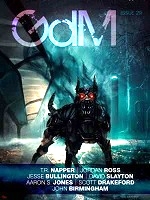“Monster/Hunter” by Jordan Ross
“The Saga of Hilde Ansgardóttir” by Jesse Bullington (reprint, not reviewed)
“The Shapes of our Fever” by T.R. Napper
Reviewed by Victoria Silverwolf
Both original stories in this issue are science fiction, violent tales of rebellion against oppression. By way of contrast, the single reprint is historical fantasy, an account of Lovecraftian horror in the time of the Norsemen.
The narrator of “Monster/Hunter” by Jordan Ross is an artificially created feline humanoid, designed to lead hunts for the extremely wealthy on another planet. The prey are also artificial beings, some fully sentient, in the form of monsters from mythology. A new client arrives, desiring the ultimate in hunting challenges. After he abuses the narrator’s friend, a partly organic and partly mechanical being, the narrator gives him what he wants.
This is the author’s first publication, and it reveals great skill with vivid description and rich characterization. The speculative content is imaginative, and the story provides both gruesome action and psychological depth. Unfortunately, the tale ends just as the narrator is about to offer the client what will be his final hunt. Even though the outcome of the implied battle is obvious, the reader is likely to wish that the story has gone on a little further.
“The Shapes of our Fever” by T.R. Napper takes place at a future time when a small number of elites, who have the privilege of extending their lives indefinitely in artificial bodies, rule over those who do not. A human woman and an android set out on a seemingly suicidal mission to invade the domain of the leader of the elites and destroy him.
This is a greatly simplified synopsis for a story with a complex background and a richly imagined future. The author offers philosophical musings on the results of separating mind and body, without neglecting to create a fast-moving, suspenseful tale. The style is unusually sophisticated for an action-filled adventure story, without becoming pretentious.
Victoria Silverwolf notes that this issue has more nonfiction articles than stories.
 Grimdark
Grimdark